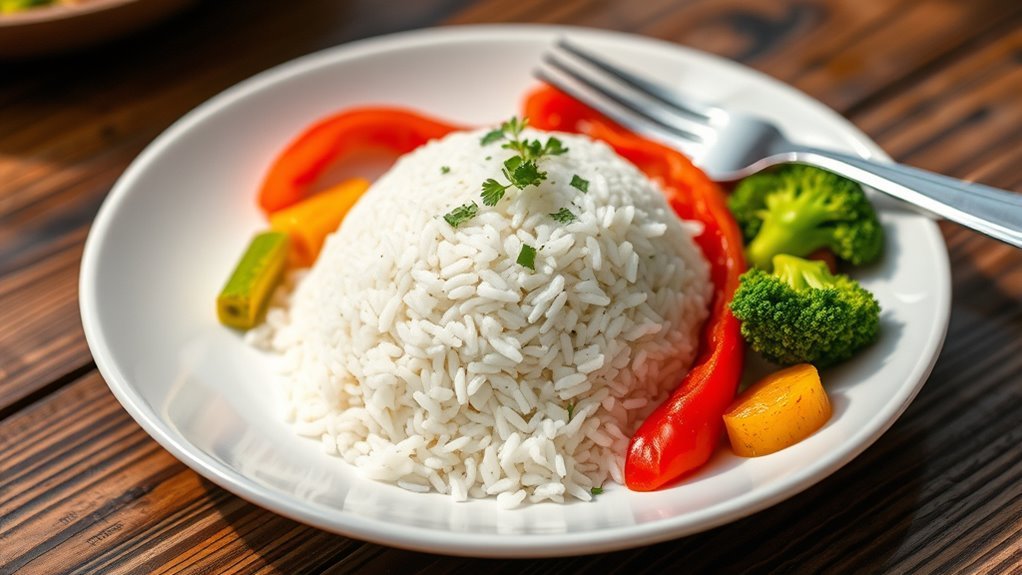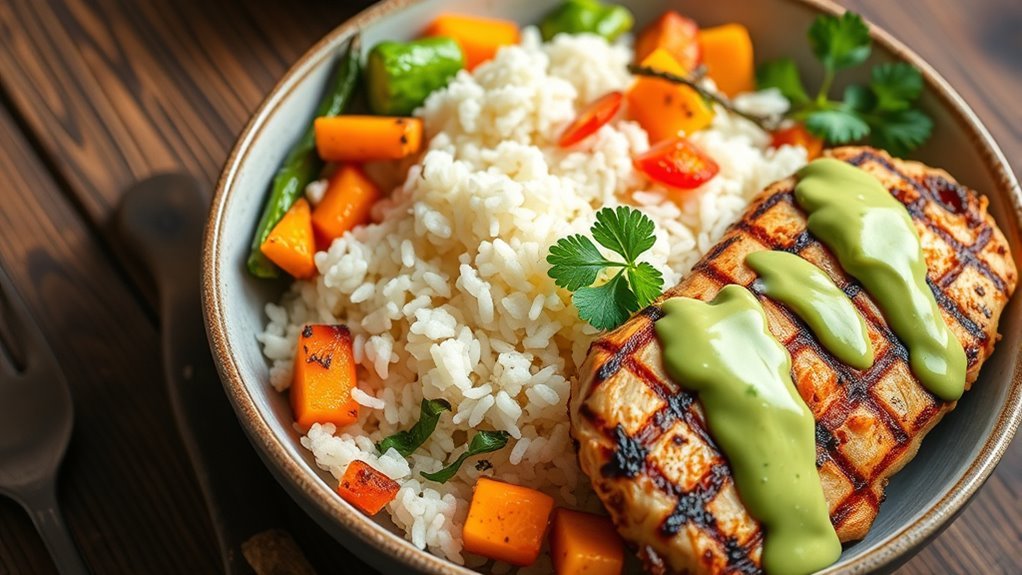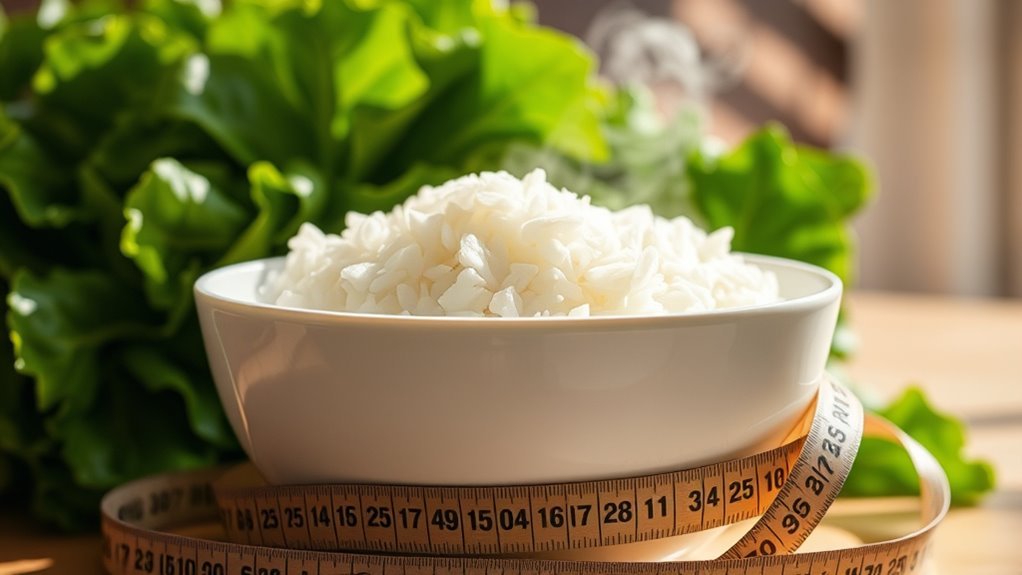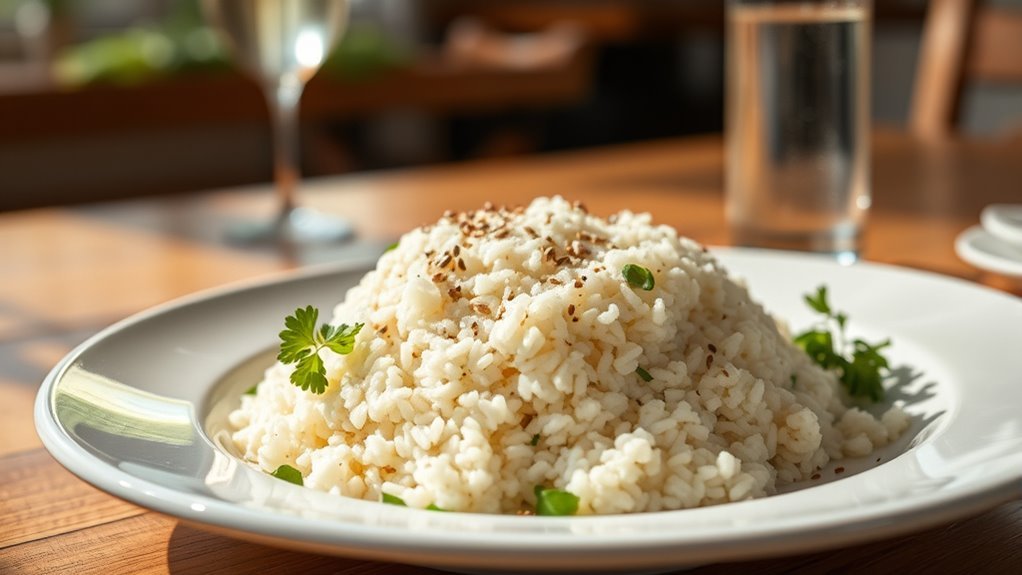You can’t eat rice on a keto diet because it’s high in carbohydrates, which can prevent you from entering ketosis. Rice spikes your blood sugar and elevates insulin levels, leading to cravings and energy crashes. Instead, consider low-carb alternatives like cauliflower rice or zucchini rice, which can absorb flavors well while keeping carbs low. These substitutes allow you to enjoy satisfying meals while sticking to your keto goals. There are plenty of creative ways to incorporate these options into your diet!
Understanding the Keto Diet and Its Carb Limits

Understanding the keto diet starts with recognizing its strict carbohydrate limits, typically capping daily intake at around 20 to 50 grams. This means you’ll need to be diligent about carb counting, ensuring you stay within these keto guidelines to achieve and maintain a state of ketosis. By drastically reducing carbs and increasing healthy fats, your body shifts from burning glucose for energy to utilizing fat stores instead. While this approach offers freedom in food choices, it also requires careful planning. You’ll want to focus on low-carb vegetables, healthy fats, and moderate protein while avoiding high-carb foods, including grains and sugars. Adhering to these principles helps you harness the benefits of the keto lifestyle, empowering your health journey.
The Role of Rice in Traditional Diets

Rice holds a central place in many traditional diets around the world, often symbolizing cultural heritage and community. It’s not just a staple food; it also provides essential nutrients and energy. Understanding how rice is prepared and consumed in various cultures can give you insight into its nutritional value and significance.
Cultural Significance of Rice
Central to many traditional diets, rice serves not just as a staple food but also as a cultural symbol in diverse regions around the globe. Its significance transcends mere nutrition, embodying various cultural variations and rice symbolism:
- In Asia, rice represents prosperity and fertility, often featured in rituals and celebrations.
- In Latin America, it’s a cornerstone of communal meals, symbolizing unity among families.
- In African cultures, rice is often associated with hospitality, serving as a welcoming dish for guests.
These cultural connections enrich the overall experience of food, making rice much more than just a dietary staple. By understanding its importance, you can appreciate the diverse traditions and values that rice holds across different societies.
Nutritional Value Overview
The cultural significance of rice is mirrored in its nutritional value, which plays a crucial role in traditional diets worldwide. Rice is a staple food that provides essential energy primarily through carbohydrates. When consumed, the carbohydrate breakdown occurs in your digestive system, converting these carbs into glucose, which fuels your body. This process delivers immediate energy, making rice a critical component for those engaged in physically demanding lifestyles. Additionally, rice offers nutritional benefits such as vitamins and minerals, including iron and B vitamins, promoting overall health. While it’s often low in fat, its high carbohydrate content means it may not align with keto principles, but understanding its nutritional value helps you appreciate its role in diverse culinary traditions.
Traditional Preparation Methods
In many cultures around the world, traditional preparation methods highlight the versatility and importance of rice in daily diets. You’ll find that these methods not only showcase different rice varieties but also reflect cultural identities. Here are some common techniques:
- Steaming: A gentle method that preserves nutrients and flavors, often used for sticky rice.
- Frying: This technique adds texture and richness, commonly seen in fried rice dishes.
- Boiling: A simple and straightforward method that’s perfect for various rice dishes.
These traditional cooking practices emphasize rice’s role as a staple food, providing sustenance and comfort. While rice may not fit into a keto diet, understanding its cultural significance can deepen your appreciation for this beloved grain.
Why Traditional Rice Is Not Keto-Friendly

Traditional rice isn’t keto-friendly primarily because of its high carbohydrate content. When you consume rice, your blood sugar levels can spike, making it challenging to maintain the low-carb state essential for ketosis. If you’re following a keto diet, it’s vital to be mindful of these effects on your body.
High Carbohydrate Content
Although rice is a staple in many diets worldwide, its high carbohydrate content makes it unsuitable for those following a ketogenic lifestyle. Traditional rice is classified as a high glycemic food, which means it can spike your blood sugar levels. This is contrary to the goal of a keto diet, which aims to keep your carbohydrate intake low.
If you’re looking for keto-friendly options, consider substituting with:
- Cauliflower rice, which is low in carbs and high in fiber.
- Zucchini noodles, offering a versatile base for many dishes.
- Shirataki noodles, made from konjac yam, providing almost zero calories.
Blood Sugar Spikes
When you consume traditional rice, your body quickly breaks it down into glucose, leading to rapid blood sugar spikes. This sharp increase in glucose can greatly disrupt your blood sugar regulation, prompting your pancreas to release more insulin. An elevated insulin response can lead to further cravings and energy crashes, making it harder to maintain a balanced diet. For those on a keto diet, which emphasizes low carb intake to promote fat burning, these spikes can derail your progress. By avoiding traditional rice, you’re not only steering clear of unwanted blood sugar fluctuations but also supporting a stable energy level throughout the day. Opting for low-carb alternatives can help you achieve better overall health and freedom in your dietary choices.
Low-Carb Rice Alternatives
If you’re looking to maintain a low-carb lifestyle while still enjoying the texture and versatility of rice, there are several alternatives that fit the bill. These options not only satisfy your craving but also pack in nutrients without the carbs. Consider these delicious low-carb rice alternatives:
- Zucchini Rice: Grated or processed zucchini mimics rice perfectly and is low in calories.
- Riced Broccoli: This nutrient-dense option adds fiber and vitamins while keeping carbs low.
- Shirataki Rice: Made from konjac root, it’s virtually calorie-free and an excellent choice for a rice substitute.
These alternatives let you enjoy your meals without compromising your dietary goals. With a bit of creativity, you can whip up satisfying dishes that keep you on track with your keto diet.
Cauliflower Rice: A Popular Substitute
Another popular choice among low-carb enthusiasts is cauliflower rice. This versatile substitute offers numerous cauliflower benefits, including lower calorie counts and higher fiber content compared to traditional rice. When you prepare cauliflower rice, you’re effectively grating or processing cauliflower florets into small, rice-sized pieces. This method retains the vegetable’s nutrients while giving you a satisfying texture for your favorite dishes. You can sauté it, steam it, or even use it in stir-fries or grain bowls, making it an adaptable option for your keto meals. Plus, its mild flavor easily absorbs the seasonings and sauces you love. By incorporating cauliflower rice, you can enjoy a filling alternative without compromising your dietary goals.
Shirataki Rice: The Miracle Konjac Option
For those seeking a truly low-carb alternative to traditional rice, shirataki rice, derived from the konjac plant, stands out as a miracle option. This versatile ingredient offers numerous shirataki benefits that make it a favorite among keto dieters.
- It’s incredibly low in calories and carbohydrates.
- Shirataki rice is high in glucomannan fiber, promoting digestive health.
- It absorbs flavors well, making it perfect for various konjac recipes.
You can whip up a satisfying meal without feeling guilty about your carb intake. Whether you’re making stir-fries or creamy risottos, shirataki rice can seamlessly fit into your culinary creations. So, if you’re looking to satisfy your rice cravings while staying on track, give shirataki a try!
Tips for Incorporating Rice Alternatives Into Your Meals
Incorporating rice alternatives into your meals can be both simple and rewarding. Start by exploring options like cauliflower rice, zucchini rice, or riced broccoli. These vegetables can be easily prepared by grating or processing them, and they absorb flavors well in various rice recipes. For meal prep, consider batch-cooking these alternatives and storing them in the fridge for quick access during the week. Spice them up with herbs, add protein, or toss in some low-carb vegetables to enhance their appeal. Don’t hesitate to experiment—try using these substitutes in stir-fries, salads, or even as a base for your favorite curries. With a little creativity, you can enjoy satisfying meals while staying on track with your keto goals.
Balancing Your Macros While Enjoying Rice Substitutes
While enjoying rice substitutes, it’s important to keep your macronutrient balance in check to confirm you’re meeting your keto goals. Rice alternatives, like cauliflower rice or shirataki, can help you stay in ketosis, but you still need to focus on macro balancing. Here are some tips to reflect on:
- Track your intake to verify you’re not overloading on carbs, even from substitutes.
- Combine rice alternatives with healthy fats and proteins to create satisfying meals.
- Experiment with different rice substitutes to find the ones that fit your macros best.
Satisfying Your Rice Cravings Without Breaking Ketosis
If you find yourself craving rice on a keto diet, you’re not alone—many people miss the texture and flavor of this staple. Thankfully, there are plenty of keto alternatives that can satisfy your rice cravings without kicking you out of ketosis. Cauliflower rice is a popular choice; it mimics the texture of rice and absorbs flavors beautifully. You can also try broccoli rice or zucchini rice for variety. Another option is shirataki rice, made from konjac root, which is low in carbs and calories. Pair these alternatives with your favorite sauces or proteins, and you’ll have a delicious meal that aligns with your keto goals. Embrace these options, and enjoy the freedom of flavorful, satisfying dishes!


